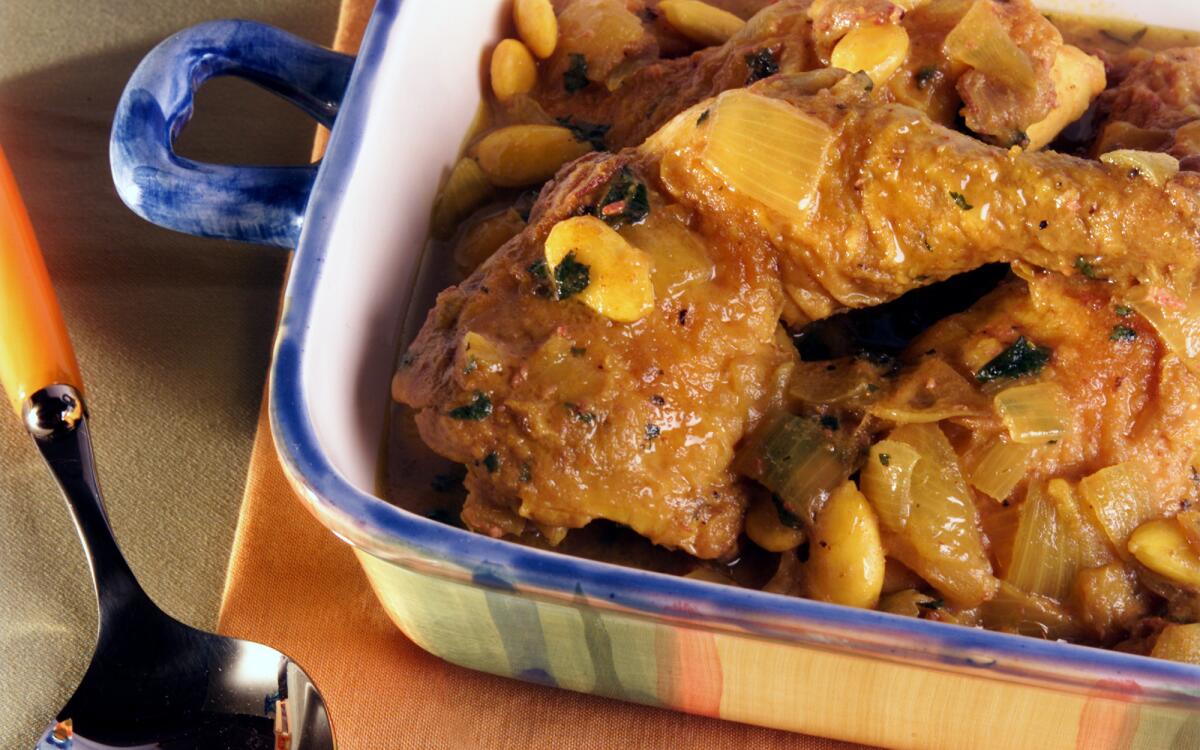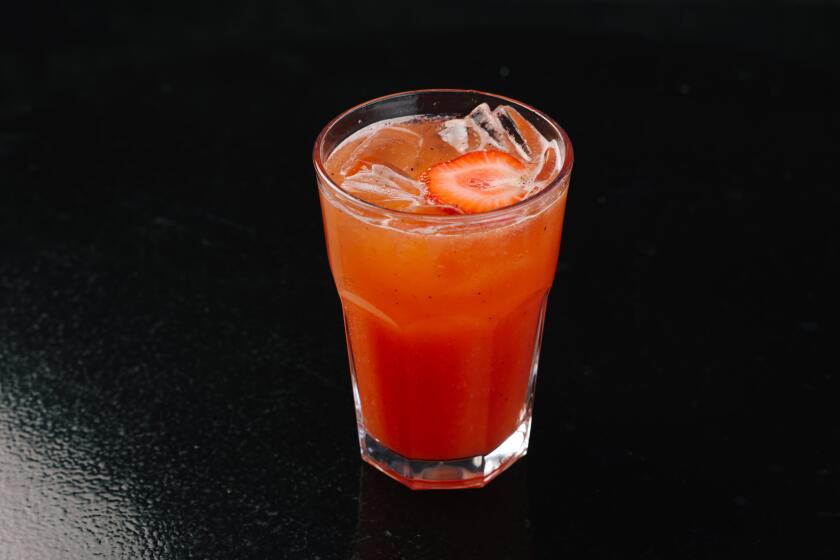Chicken casserole with dates and almonds

The religious calendar waits for no one; despite the political turmoil, violence and ever-present threat of more terrorist attacks and suicide bombers, Jews here and throughout the world are in the midst of celebrating Sukkot, an eight-day harvest festival (seven in Israel) known alternately as the “The Season of Our Joy,” and the “Festival of the Ingathering.”
Coming just after the Days of Awe-the period from Rosh Hashana (the Jewish New Year) and Yom Kippur (The Day of Atonement)--Sukkot is actually the most important festival of the agricultural and spiritual year. Just as that other eight-day festival, Passover, is the “season of our liberation,” so Sukkot, which began Monday evening and lasts for a week, is the time we joyously celebrate the true end of the Judgment period and the chance for a new beginning.
Like Thanksgiving, Sukkot is also a time to celebrate the bounty of our fields and orchards before the first rains and the winter season set in. In ancient times Sukkot was an “in-gathering” in another sense as well, for like Passover (and Shavuot), it was a pilgrimage festival. Tens of thousands of ancient Israelites would gather on the Temple Mount in Jerusalem for the holiday and its culminating joyous water libations--waters that the prophet Zechariah envisioned flowing out from Jerusalem to redeem the world.
So last week, if you happened to notice a Jewish neighbor nailing boards together and gathering branches for a transient-looking shack in his backyard, he wasn’t in the doghouse (or even building one). He was merely observing the Biblical commandment found in Leviticus: “In booths [ sukkot ] ye shall dwell seven days ... that your generations may know that in booths I made to dwell the children of Israel, when I brought them out from the land of Egypt.” If you’ve also noticed that same neighbor walking around with a fragrant yellow fruit (the citron or etrog ) and a bunch of tall leaves (the lulav ), don’t be surprised, either. These too are part of the Sukkot holiday. On the first day of the holiday the Bible instructs, “You shall take the product of goodly trees, branches of palm trees, boughs of leafy trees, and willows of the brook, and you shall rejoice before your God.”
These “Four Species,” to which many mystical meanings were attached, were another part of the festival ritual thousands of years ago at the temple, and are today part of holiday prayers--particularly those for rain. (In Israel, just as in Southern California, this is the end of the long dry season that evokes hope for vital winter rain.)
Building a sukkah is usually not a last-minute task; often the devoted start working right after the Days of Awe to construct the makeshift huts from wooden poles and a roof of palm fronds. In Israel, building a sukkah is not so hard--many towns and cities have a local fair where you can buy various types of frames to make life easier, along with decorative panels and accessories to embellish your sukkah as your budget will allow.
Many American hardware chains--especially those in Jewish neighborhoods--carry everything you’ll need to build a sukkah as well. In Tel Aviv, even Tel Aviv’s municipal gardeners are enlisted to distribute already-cut palm branches at local drop-off points for sukkah -building on rooftops, balconies and backyards. In sister-city Los Angeles, neighborhood synagogues also make the materials for the sukkah easily available.
Sukkot is also associated with beauty; the Talmud suggests decorating the shelters, through whose roof one must be able to see the stars at night, with “handmade carpets and tapestries, nuts, almonds, peaches, pomegranates, branches of grape, vines ... wreathes of ears of grain.”
Within the sukkah, Jewish people eat their meals, study, sing, relax, and in modern versions of kabbalistic tradition, invite holy symbolic guests--the beloved matriarchs and patriarchs of the Bible, as well as great men and women of the past who are important to us.
From a culinary standpoint, there are no “Sukkot standards,” such as the potato pancakes and jelly doughnuts for Hanukkah or three-cornered hamantaschen cookies for Purim.
Traditionally, Sukkot fare is supposed to reflect the rich bounty of harvest, with an accent on seasonal fruits and vegetables. In Israel, it is just after the grape harvest and the fig season, but there are also fresh dates, pomegranates and the beginnings of fresh-pressed olive oil as in Biblical times--as well as a plethora of exotic modern-day fruits such as cherimoyas, kiwi and litchis The guideline in planning a Sukkot menu is convenience-dishes that can be transported easily from home to hut without much ado, such as hearty soups or casseroles. Among Ashkenazic Jews, it’s another opportunity for chicken soup with kreplach (in keeping with the tradition of stuffed foods, symbolizing God’s “covering us in loving kindness”), while Sephardic Jews use it as another excuse to enjoy couscous. Vegetarians of all persuasions can feast on stuffed vegetables, pumpkin-or spinach-stuffed ravioli, or even a hearty lentil soup, accompanied by salad and an earthy bread.
Dust the chicken lightly with the flour. Heat the oil in a Dutch oven over medium heat and cook the chicken in two batches, turning, until golden brown on each side, about 5 minutes a side.
Return both batches of chicken to the pot and add the onions. Mix together the cumin, coriander, ginger and turmeric and sprinkle over the chicken, distributing evenly. Cook for 2 to 3 minutes, stirring to prevent burning. Pour in the broth and lemon juice, and salt and pepper to taste.
Bring to a boil over medium heat, then reduce the heat slightly and stir in the dates and almonds. Cook, covered for 20 minutes. Uncover and simmer until the chicken is very tender, 10 to 15 minutes, stirring occasionally. Let the chicken sit about 5 minutes, then skim off the excess fat. Add the cilantro, cover, and let stand 5 minutes more before serving.
Get our Cooking newsletter.
Your roundup of inspiring recipes and kitchen tricks.
You may occasionally receive promotional content from the Los Angeles Times.















